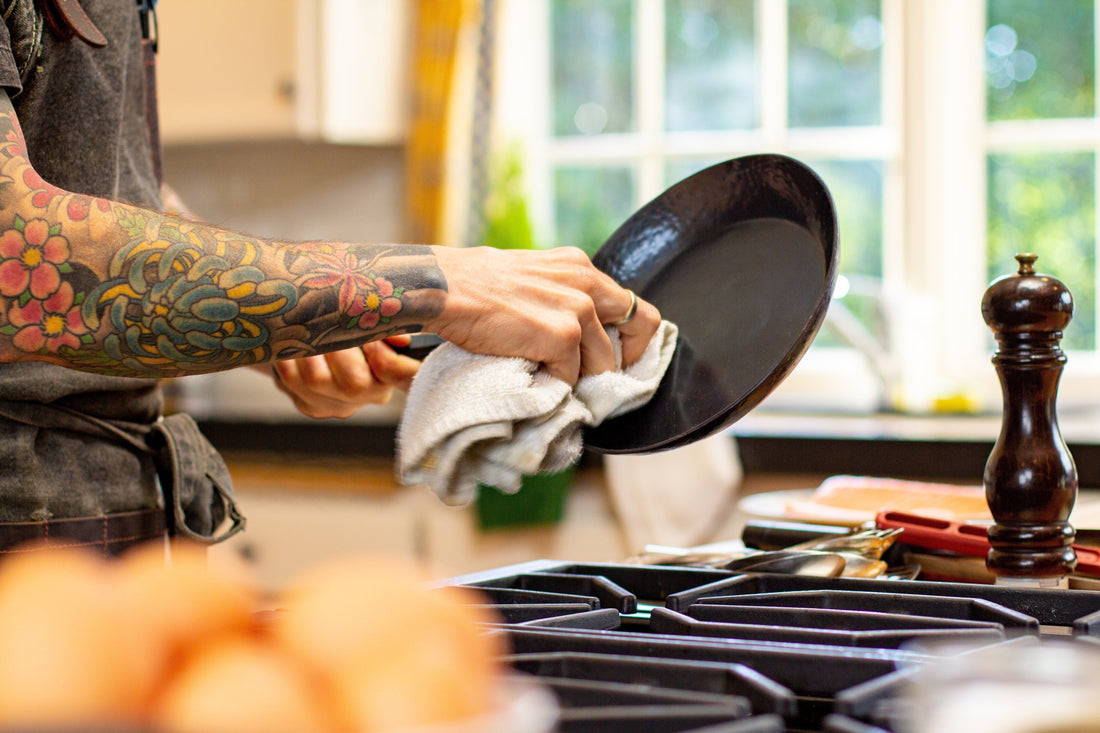
Carbon Steel Pan Seasoning & Care Guide
Carbon steel pans develop their legendary nonstick properties through proper seasoning—a process that transforms your cookware into a better tool with every use. At Santa Barbara Forge, we pre-season our pans with coconut oil so they're ready to cook immediately, but understanding how to maintain and enhance this seasoning will unlock your pan's full potential.
Understanding Carbon Steel Seasoning
Seasoning creates a natural, protective coating through polymerization—heating oil beyond its smoke point until it bonds molecularly with the metal surface. This process builds layers of protection that prevent rust, reduce sticking, and improve with time and use.
Carbon steel offers distinct advantages over cast iron: it's lighter, heats more quickly, and responds better to temperature changes, making it ideal for searing, stir-frying, and professional-style cooking techniques.
Safety Notice
Proper seasoning involves high heat and hot oils. Always use oven mitts, ensure adequate ventilation, and never leave heated pans unattended. Santa Barbara Forge assumes no responsibility for damage or injury resulting from pan care procedures.
Getting Started with Your Pre-Seasoned Pan
Your Santa Barbara Forge pan arrives ready to cook, but the first few uses are critical for establishing a strong seasoning foundation:
- Use generous amounts of oil during initial cooking sessions
- Cook dry or high-fat foods first—avoid acidic ingredients like tomatoes or vinegar until seasoning is well-established
- Expect some initial sticking—this is normal and will improve with consistent use
Additional Seasoning (Optional)
To accelerate seasoning development, you can add additional layers using this method:
Materials Needed
- Neutral, high-smoke-point oil (grapeseed, flaxseed, or vegetable oil)
- Paper towels
- Heat-resistant gloves
Process
- Clean and dry the pan thoroughly with hot water (no soap necessary)
- Apply oil sparingly—a few drops rubbed over all surfaces until the pan appears dry, not greasy
-
Heat until smoking using either method:
- Oven method (recommended): Place upside-down at 450-500°F for one hour
- Stovetop method: Heat over medium-high heat until oil darkens and smokes
- Cool completely and repeat 2-3 times for optimal results
Note: Blotchy appearance is normal initially and will even out with use.
Daily Maintenance
Regular Cleaning
- Wipe clean with paper towels after cooking when possible
- Rinse with hot water and scrub gently for stuck food
- Avoid soap when possible to preserve seasoning
- Apply light oil coating if soap was used
Deep Cleaning
For stubborn residue:
- Add water and simmer briefly
- Use wooden spatula or scrubber to lift debris
For rust spots:
- Remove rust with steel wool
- Dry completely and re-season affected areas
Troubleshooting Common Issues
Food Sticking: Increase oil usage and continue regular cooking—seasoning improves with time
Blotchy Appearance: Normal for new seasoning; will even out with continued use
Rust Development: Remove with steel wool, dry thoroughly, and re-season
Conclusion
Carbon steel pan maintenance requires consistency rather than complexity. Each cooking session contributes to the seasoning, gradually transforming your pan into a superior cooking tool. With proper care, your Santa Barbara Forge carbon steel pan will provide a lifetime of professional-quality performance.
Discover our collection of handcrafted carbon steel pans: Sonora Collection

4 comments
Thanks for schlepping all your supplies to Terra Madre! Spectacular craftsmanship
My son would love to come in with his 8 year old for a field trip and purchase a pan.he is local,is that possible?
Yes it’s normal. Especially with bacon on a new seasoning. Try putting the bacon in a COLD pan next time then heat it up. Also you’ll have better luck allowing food to get to room temp before you cook
Purchased the small fry pan. Love it. Problem: Seasoned it in oven per directions. Cooked some bacon on it this morning. Brown fond on pan so used a soft bristle and plain water to remove it but it took a lot of the seasoning off the pan to bare metal. Reseasoned with high smoke point oil. Hopefully I can build it back up. Is this normal?